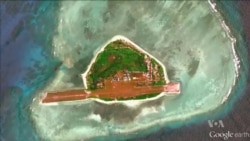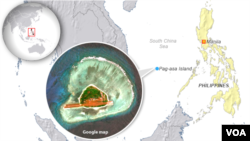A small Philippine island is at the forefront of China’s expansion into Southeast Asian waters. In a region that Beijing claims is its historic territory, its armed forces have built a cluster of artificial islands within what’s known internationally as the Spratlys - an approximately 425,000 square kilometer swath of the South China Sea, consisting of several hundred islets, rocks and reefs. Of those, Pag-asa island is one of the largest and most populated.
For its 117 Filipino residents, the main way to travel between their homes and Puerto Princesa, the capital of Palawan province, is a wooden hull cargo-ship - the M/V Queen Seagull.
On a recent afternoon at the city’s main harbor, bags of soil and fertilizer were loaded onto the boat’s deck. In a few weeks she will make the two-day long journey to Pag-asa, part of Kalayaan, the Philippines’ most western municipality.
Growing in population and jobs
Over the past several years, the community there has grown five-fold, an increase that Kalayaan’s mayor, Eugenio Bito-onon Jr., attributed to the availability of steady jobs on the island and perhaps a sense of Filipino patriotism.
“We can say it’s symbolic, it stands for our sovereignty”, he said.
Manila began stationing soldiers and providing homes for civilians on Pag-asa in the 1970s to reinforce its territorial claims in the South China Sea.
China has been aggressive in the area
The Philippines has had disputes with its neighbors over the Spratlys for decades. Vietnam and Malaysia both seized atolls that the mayor considers part of his jurisdiction. China is the latest, and perhaps most aggressive, country to make land grabs in the area.
The mayor said on a handful of occasions during trips to Pag-asa, the Chinese Coast Guard trailed his boat and once blocked his access to part of his municipality.
But Mayor Bito-onon maintained that very few of Pag-asa’s residents, who generally stay close to the island, ever encountered the Chinese forces.
Thirty-nine-year old Nonalon Belbontin, his wife and young daughter are among those who call the island home. They are currently in Puerto Princesa receiving medical care.
Despite the long boat ride, four hours of daily electricity and rationed meals on Pag-asa, the construction worker said he had a “normal life and a good job” there. “My family is happy,” he said.
All three will be on board the Queen Seagull when it sets sail in September.
Belbontin said that he’s aware of the tensions between his country and China in the waters surrounding his home, but Beijing’s “bullying” doesn’t bother him personally.
“I am not afraid of China, we have the military protecting us”, he said. ”The dispute does not affect my life or work."
Observers off the island are perhaps more concerned about the pace that China has moved into what Manila says is its exclusive economic zone.
Threat to the Spratlys and the entire region
Chito Santa Romana, who heads the Philippine Association of Chinese Studies, said China was now seen as the biggest threat to regional security.
He said that Beijing’s artificial islands construction, which include military outposts and even an airplane landing strip, has “alarmed its neighbors” and “eroded trust and confidence” toward China throughout Southeast Asia.
Beijing’s Foreign Ministry has said that its land reclamation in the South China Sea has been completed, but Romana said it's still unclear what purpose these new islands would serve.
The best vantage point
While looking at the map that hangs on his office wall in Puerto Princesa, Mayor Bito-onon pointed to the various rocks and reefs that China now occupies.
“It’s a big reclamation already”, Bito-onon said, gesturing to the location of one of China’s new man-made islands just 21 kilometers from Pag-asa. “Especially during the evening you can see, it's like a city.”









